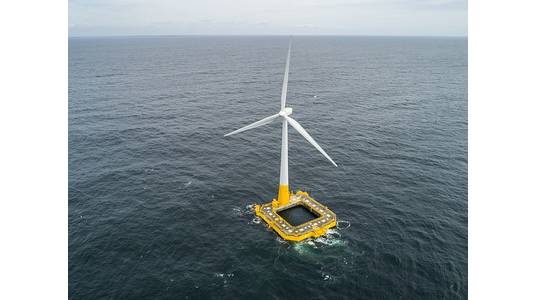
Floating Offshore Wind (FOW) is set to be the next big thing in renewable power. It can unlock huge wind potential in new areas globally, but it will also enable many countries lacking suitable seabed conditions for fixed bottom wind to realize large economic benefits.
Although FOW has the potential to become a huge global industry, there are still a number of hurdles that the industry must cross in order to become commercially attractive in terms of Levelized Cost of Electricity (LCOE).
Whereas the price for delivering offshore wind energy in 2019 ranged between $48 and $60 per MWh of electricity, current auctions for floating wind are priced over twice that amount. This means more investment capital is needed to get projects off the ground, and of course higher electricity costs for the end user.
One cause of this additional cost are the foundations used for floating offshore wind, which can be truly massive in scale. At their upper end, these giants can weigh tens of thousands of tonnes each; substantial fabrication projects of steel or concrete.
What’s more, in some countries the installation window is reduced to only six months per year, due to weather or environmental restrictions. So, the pressure is truly on for supply chains to mature rapidly – with an end goal of meeting the pace at which OEMs can produce turbines.
Floating offshore wind development has to date focused on prototype projects with limited scope and highly varied designs. Through standardized design principles and modularized mass manufacturing strategies, construction can take place in parallel and economies of scale can be enjoyed that will lower the capital investments needed - making offshore wind more viable for more countries.
To achieve the goal of launching one floater per week, every element of the fabrication, logistics, and construction chain must be fundamentally reimagined. A daunting task – but luckily, one that has been tackled successfully before in many industry sectors.
Another important area where efficiencies could be realized is the launching process for the floating foundations themselves. These vary substantially in size, shape, and weight from project to project. Just placing these large units in the water alone requires significant infrastructure, planning, and investment.
There are currently four main types of floating foundation technology; each designed for different water depths and seabed soil types: semi-submersible, tension leg platform, spar, and barge. Each has its own specific advantages and challenges.
While these designs have allowed many countries with different environmental conditions to enter the market, they also mean that there is no standardized launching methodology used across the industry. Therefore, bespoke engineering is often required to float-off, ultimately driving up costs. Let’s take a look at the options.
Dry dock
The easiest way to build these structures would surely be in a dry dock. However, given the investment required to build dry docks at the scale required it is no surprise that there are no facilities available or planned to be constructed for this purpose.
Slipway
For centuries, the main launching method shipyards have used for vessels is the slipway, but for similar reasons to dry docks, for example, availability and size, this method is also not feasible.
Semi-submersible vessels or platforms
The most common and proven method used until now for demonstration floating offshore wind projects and pre-commercial scale projects. Despite the partial consensus, it is unclear if - for large scale commercial projects - the readiness and cost of the vessels might limit their usage.
This type of float-off operation requires considerable water depths that are commonly not available inside a port, potentially resulting in considerable delays to projects, due to weather. It also limits where fabrication and marshalling can be performed, and by extension the content that can be executed locally – a key concern for governments.
Hybrid systems
Alternative tandem solutions, combining lifting means from both land and sea, can be used to lower these structures into the water - for example, using shear legs, heavy lift vessels or barge cantilevers, together with onshore lifting solutions. The complexity of these operations is still considered a risk as the industry is yet to see a fit-for-purpose system that can be used in an industrialized way.
Heavy lift crane
When combined with fabrication activities (for example, receiving large components from overseas) the capacity to lift the floater directly into the water and install the turbine in one single location would lead to a clear increase in possible production rates - though such equipment demands a suitably strong quay to withstand the pressures of both crane and substructure.
Using a heavy lift crane would also allow developers to shift installation costs from offshore to onshore. Rather than using a heavy installation vessel to install each turbine at sea, they can instead be assembled at the quayside by a crane with sufficient height, reach and capacity to do so.
By executing as much work as possible from a single location, in as large units as possible, with as few interfaces as possible, the floating offshore wind sector can enjoy tried-and-tested economies of scale. Early engagement with companies experienced in bringing breakbulk cargoes together over huge distances is key to optimize these processes and multiply the benefits realized years down the line.
Through standardized fabrication and a mature supply chain, floating offshore wind can help the world towards its 2030 and 2050 climate commitments, and a more sustainable future.



